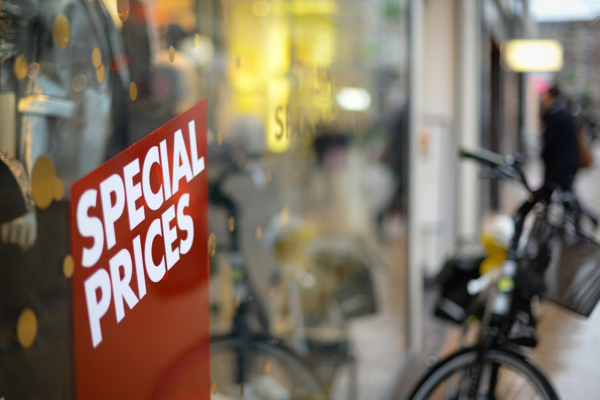How to Improve Your In-Store Signage

As a small business owner, capturing the attention of current and prospective customers while communicating your products, services, or offers in a short amount of time is not an easy feat, but in-store signage can help.
In-store signage refers to the signs that exist in your store that display information, whether it be a new product offering, a sale, contest details, directions to certain parts of your store, etc. It is important to ensure that these signs have a purpose and benefit your business rather than distract or take up space. Keep reading for tips on how you can optimize your in-store signage to help improve the customer experience.
Stick to Your Brand Guidelines
A great way to boost your small business’s brand recognition is to maintain your specific branding in all material you produce, in-store signage included. Creating a consistent brand experience for customers is important for establishing and reinforcing brand identity, and that starts with upholding your brand guidelines. Ensure you maintain the same font, colours, logo, illustration style, and verbiage when producing in-store signage, as this can help solidify who you are as a brand. Since 61% of consumers are more likely to purchase from a brand they recognize, producing material that will help boost brand recognition is crucial for small businesses. Plus, consistent branding can lead to a 33% increase in revenue.
Staying on-brand when creating in-store signage can also create a cohesive environment for customers entering your store, as your printed material will match the look and feel of the rest of your store. This consistency can add to a positive in-store ambience and brand experience.
Place Signs in Optimal Spots Around Your Store
Having a placement plan is crucial to enhance your in-store signage. Adding signs that direct customers to certain areas of your store, for example, can be an excellent way to ensure your customers can navigate your store efficiently, further improving their experience. However, it’s important to place these signs in locations where customers can easily see them. Therefore, mapping out where you want to add signs first is a good place to start.
Where you place your in-store signage depends on your store, but starting with high-traffic areas where most of your customers go can be beneficial. For example, if you have a great sale, placing a sign in this area can help increase awareness. However, signs don’t have to be near the products—you can add them to your windows to grab the attention of those inside and those passing by, at checkout to promote impulse purchases or loyalty programs, on your walls, etc. Finding a balance that works with your store is key.
Aim for More Visuals Than Text
Let’s say you have a new product available and want to create signs in your store to help promote it. Your focus should be on capturing customer attention and encouraging them to buy the product rather than overwhelming them with too much text that they end up not looking at the sign or the product altogether. Therefore, it’s often a good idea to use more visuals and maintain a balance of text, if necessary, rather than vice versa. Of course, text can be an important way to add context to your signs, but try keeping it to a minimum and ensure it is concise so as not to overpower the visuals.
Visuals can help effectively transmit information to the brain, as our brain processes images 60,000 times faster than text can. Additionally, researchers at MIT have established that the brain can identify images in 13 milliseconds. Therefore, opting for more visuals on your in-store signage can allow customers to comprehend what you’re communicating at a much faster rate.
The picture superiority effect, which is the idea that people are more likely to remember images than words, can also play a significant role here. It is likely why you see symbols and images on workplace safety signs, for example, as it allows for swift processing speeds and greater retention. As a small business owner, finding ways to enforce customer recognition can assist in building long-lasting relationships, so incorporating more visuals into your in-store signage can offer both short- and long-term benefits.
Ensure Legibility and Accessibility
Your signage should be clear and easy to understand by all customers, and that starts with your design, including the colours you use and the text you use. Of course, staying on brand is important, but all signage should be legible.
Using online tools to assist with this can be a huge help. This colour contrast checker, for example, can calculate the contrast ratio of a background colour compared to the text colour and provide a rating on how well the contrast is; the higher the contrast, the greater the rating.
Since more than six million Canadians aged 15 and over have a disability, other ways you can ensure your signage is accessible is with large text that does not use hard-to-read font, following the accessible signage guidelines by Braille Literacy Canada, and ensuring that the signage is placed in a convenient space that maintains wide enough aisles of your store.
Create In-Store Signage with The UPS Store
Ready to improve your in-store experience through signage? The UPS Store can help. We have several printing options, such as posters, counter signs and roll-up banners, that can bring your ideas to life. We also offer online printing options, which you can access here.
Visit The UPS Store in your neighbourhood to speak with an expert on how you can elevate your small business today!